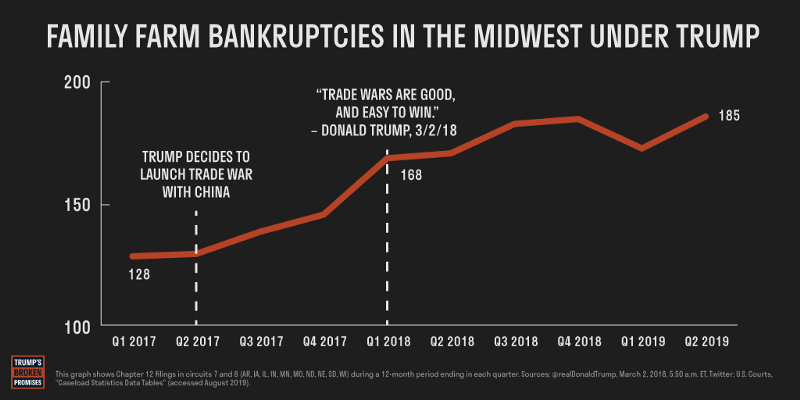
In Des Moines, Iowa, in September 2016, Donald Trump promised that he would “negotiate trade deals to help our farmers, help them export their goods, and make money doing it.”
In reality, the Trump administration’s policies have wreaked economic havoc on family farmers. In today’s update, we highlight how farmers are worse off under the Trump administration.
Share this video on Facebook and Twitter featuring Les, a soybean farmer from Wisconsin, to spread the word on how Trump’s broken promises are hurting farmers:
For more on the impacts of Trump’s broken promises across the country, head to TrumpsBrokenPromises.org.
FIVE FACTS ON TRUMP’S RECORD WITH FARMERS
1. Farmers have lost $8.4 billion in profits due to the Trump administration’s trade policies. As a result, net farm income in 2018 was down 16% from the previous year. The program meant to provide relief to the most affected farmers has largely ignored small and minority-owned farms.
2. The number of claims of Chapter 12 bankruptcy in the 7th and 8th Circuits, which is available only to farmers and ranchers, has increased 45% since Donald Trump took office. These circuits, which are composed of the breadbasket states Illinois, Indiana, Wisconsin, Arkansas, Iowa, Minnesota, Missouri, Nebraska, and the Dakotas, are facing unprecedented bankruptcy rates, despite the Trump administration’s farm bailouts.
 Share this graphic on Twitter.
Share this graphic on Twitter.
3. The Trump administration’s attacks on the Affordable Care Act threaten the health insurance of family farmers, whose “natural resources” employment group saw the uninsured rate decrease from 31.7% to 23.4% from 2010 to 2017. If the Trump administration is successful in repealing the ACA, some 1.5 million workers in this employment category could lose their insurance.
4. The U.S. recently experienced its wettest 12 months in recorded history, with spring floods causing $12.5 billion in damage across the Midwest, and scientists expect the U.S. to face more extreme weather in the coming years due to climate change. Yet when asked about the predicted effects of climate change, Trump responded, “I don’t believe it.”
5. Market concentration has shot up across the agricultural sector in recent years, yet one of the USDA’s first acts under the Trump administration was to withdraw Obama-era rules that protected family farmers from unfair and deceptive contracting practices. This contradicts the fact that nearly three-quarters of farmers believe that it is important to strengthen farmers’ bargaining position when dealing with companies that control production chains.
DEEP DIVE
TRADE POLICIES
Donald Trump promised to be a champion for family farmers. Instead, farmers have lost some $8.4 billion to the Trump administration’s bellicose trade policies.
To save face with core supporters, the Trump administration has been paying farmers for their financial losses through the Market Facilitation Program. In direct contrast with the Trump administration’s insistence that China will pay for the tariffs, in 2018 the MFP shelled out roughly 130% of what the tariffs brought in. American taxpayers, as it turns out, are paying for the tariffs.
And while there may be merit in compensating economically distressed farmers for trade policies that lead to widespread economic gain, the Trump administration is unfortunately not allocating payments equitably. According to data retrieved by the Environmental Working Group, the top 1% of MFP recipients received an average of $183,331, while the bottom 80% received an average of less than $5,000.
The USDA has also reversed a prior position in which MFP payments would be capped at $125,000 and provided 82 farmers with more than $500,000 in payments. One farm alone has received $2.8 million in MFP payments.
Meanwhile, net farm income has nearly halved over the past five years, shrinking from $123 billion to $63 billion; dairy farmers alone have lost $2.3 billion in revenue since the trade war began.
BANKRUPTCY
The Trump administration’s trade policies have absolutely devastated family farmers’ solvency too. The number of claims filed for Chapter 12 bankruptcy — which is unique in that it is only available to family farmers and fishermen — has increased 17% since Donald Trump took office.
More worryingly, the number of claims filed in the 7th and 8th Circuits, which constitute agriculture-heavy states like Arkansas, Iowa, Minnesota, Missouri, Nebraska, and Wisconsin, have spiked 45% over the same time period.
Farm delinquencies are on the rise as well; 2.5% of agricultural commercial real estate loans were over 30 days past due in the first quarter of 2019, compared to 2.1% in the previous quarter. The rate of 30-day delinquencies for non-real estate loans likewise increased, from 1.5% in Q4 of 2018 to 2.3% in Q1 of 2019.
HEALTH CARE
In 2017, Trump stated that his administration would “have insurance for everybody” with “lower numbers [and] much lower deductibles.”
As a result of the Affordable Care Act, the uninsured rate among workers in the “natural resources, construction, and maintenance” category dropped the most of any employment category; from 2010 to 2017, it went from 31.7% to 23.4% — a decrease of 7.7 percentage points.
Instead of defending the law of the land that has provided tens of millions with health insurance, the Department of Justice is siding with the plaintiffs litigating against the ACA. If the Trump administration is successful in repealing the ACA in its entirety, the roughly 1.5 million workers in the “natural resources” category, which includes farmers, could lose coverage.
A full repeal of the ACA would also disproportionately harm Hispanics and those who have completed some college or less, who work on farms at higher rates than Americans overall. Only 6.6% of workers in the “natural resources” employment category have completed college, compared to 33.6% of all American workers. Those who identify as Hispanic work in this same employment category at a rate 65% higher than they do across all employment categories.
CLIMATE CHANGE
The U.S. recently experienced its wettest 12 months in recorded history, with spring floods causing $12.5 billion in damage across the Midwest. Farm communities along the Mississippi and Missouri Rivers remained inundated at flood stage for over 100 consecutive days, which ruined million acres of production and led to historically slow planting seasons for corn and soybeans crops.
Scientists expect the U.S. to face more extreme weather in the coming years due to climate change, and without prompt action “on a sweeping scale,” climate change will cut crop yields in half this century. Yet when asked about the predicted effects of climate change, Donald Trump responded, “I don’t believe it;” Agriculture Secretary Sonny Perdue claimed, “I think it’s weather patterns, frankly.”
The Trump administration’s most recent proposal would cut USDA programs by $61.3 billion over the next ten years, including a $26 billion cut to crop insurance programs.
The Trump administration has also refused to publicize government-funded studies estimating climate change’s future effect on agriculture, leading career USDA scientists to resign. Administration officials also cancelled the release of a multi-year climate response plan, outlining how the USDA should help farmers mitigate climate change’s effects.
The Trump administration likewise proposed eliminating the Conservation Stewardship Program, which compensates farmers for carbon capture and conservation practices on working lands.
As extreme weather conditions become the new normal, America’s farmers need innovative solutions for climate resilience. The agricultural industry will be unable to mitigate and adapt to the climate crisis without significant federal investment and research, which the Trump administration has failed to provide.
MARKET CONCENTRATION
The four-firm concentration ratio, defined as the percent of market share held by the four largest firms in an industry, is considered in oligopoly or monopoly territory when it breaches 40%. In the agricultural sector, this ratio has been on the rise for decades, and in many subsectors it often far surpasses the 40% mark.
For example, four grain traders control the movement of 73% of the world’s grain, and the four-firm concentration ratio in the beef packing industry is 82%. In response to these stark numbers, the Obama administration in 2016 implemented rules that required the Grain Inspection, Packers, and Stockyard Administration (GIPSA) to outline what constitutes deceptive and unfair contracting.
Rather than uphold a law that protects family farmers, one of the Trump administration’s first acts was to withdraw these competition-fostering rules. Even worse for family farmers and consumers, the Trump administration decided that the goals of GIPSA, which were to promote fair and competitive practices in the agricultural sector, were non-essential and shuttered the agency in 2017.
The Trump administration is also actively ignoring what farmers actually want. A survey by the Union of Concerned Scientists found that:
- 75% of farmers want incentives to reduce runoff and soil loss, improve water quality, and increase resilience to floods and droughts.
- 74% of farmers want to strengthen their standing in dealings with companies that control the production chain.
- 74% of farmers want policies that support research on how to decrease the need for costly chemical inputs.
In contrast, the Trump administration has gutted the Environmental Protection Agency, making it much more difficult to achieve these goals.
For more on the impacts of Trump’s broken promises across the country, head to TrumpsBrokenPromises.org.